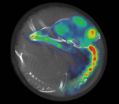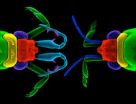Extra gene drove instant leap in human brain evolution
2012-05-04
(Press-News.org) A partial, duplicate copy of a gene appears to be responsible for the critical features of the human brain that distinguish us from our closest primate kin. The momentous gene duplication event occurred about two or three million years ago, at a critical transition in the evolution of the human lineage, according to a pair of studies published early online in the journal Cell, a Cell Press publication, on May 3rd.
The studies are the first to explore the evolutionary history and function of any uniquely human gene duplicate. These "extra" genes are of special interest as they provide likely sources of raw material for adaptive evolutionary change. Until now, studying them has been a technical challenge because they are nearly indistinguishable from each other.
"There are approximately 30 genes that were selectively duplicated in humans," said Franck Polleux, an expert in brain development at The Scripps Research Institute. "These are some of our most recent genomic innovations."
Intriguingly, many of these genes appear to play some role in the developing brain. Polleux and Evan Eichler, a genome scientist at the University of Washington, focused their expertise and attention on one of the genes known as SRGAP2. This gene has, in fact, been duplicated at least twice during the course of human evolution, first about 3.5 million years ago and then again about 2.5 million years ago.
The new work shows that the second and relatively recent duplication event produced only a partial copy of the gene. This copy acts at exactly the same time and place as the original, allowing it to interact with and block the ancestral gene's function.
"This innovation couldn't have happened without that incomplete duplication," Eichler said. "Our data suggest a mechanism where incomplete duplication of this gene created a novel function 'at birth'."
Interestingly, the novel gene appears to have arisen just as the fossil record shows a transition from human's extinct Australopithecus ancestors to the genus Homo (as in Homo sapiens), which led to modern humans. That's also when the brains of our ancestors began to expand and when dramatic changes in cognitive abilities are likely to have emerged.
The researchers don't think SRGAP2 is solely responsible for that brain expansion, but the genetic interference does have potential benefits. Polleux and colleagues mimic the function of the human-specific SRGAP2 duplication in mice. They show that loss of SRGAP2 function accelerates neurons' migration in the developing brain, potentially helping them reach their final destination more efficiently. Moreover, neurons that have decreased SRGAP2 function, due to expression of the human-specific SRGAP2 display more knob-like extensions or spines on their surfaces, making the neurons appear much more like those found in the human brain. These spines enable connections between neurons to form.
In addition to providing insight into the origins of the modern human brain, the findings offer clues to the neurodevelopmental disorders that humans are so prone to developing, including autism, epilepsy and schizophrenia, in which development of neuronal connections is affected. The researchers point to known cases of humans with structural brain defects and other symptoms that can be traced to disruption of the ancestral SRGAP2. They now intend to search for people carrying defects in the human-specific 'granddaughter' copy as well.
If this gene duplication did indeed produce an immediate effect during evolution as Eichler and Polleux suspect, they expect there must have been a fascinating period in human history characterized by "huge variation" in human cognition and behavior. SRGAP2 and other human-specific gene duplicates might also help to explain the big differences between humans and other primates, despite few apparent differences in our genome sequences.
"We may have been looking at the wrong types of mutations to explain human and great ape differences," Eichler says. "These episodic and large duplication events could have allowed for radical – potentially earth-shattering – changes in brain development and brain function."
###
Charrier et al.: "Inhibition of SRGAP2 function by its human-specific paralogs induces neoteny during spine maturation."
and
Dennis et al.: "Human-specific evolution of novel SRGAP2 genes by incomplete segmental duplication."
ELSE PRESS RELEASES FROM THIS DATE:
2012-05-04
Oscar-nominated film Moneyball has inspired a data revolution of sorts within the field of human resources. Like Brad Pitt's character in the movie, numerous HR professionals are embracing the value of data and dedicating a great deal of time to analysis in an effort to determine the best HR moves for their organizations. Trummell Valdera, an HR expert who has led many a company to success in its HR operations, has adopted a similar approach. In fact, Trummell Valdera is urging other HR professionals to consider the immense value that such data can provide.
In Moneyball, ...
2012-05-04
Under some conditions, the brains of embryonic chicks appear to be awake well before those chicks are ready to hatch out of their eggs. That's according to an imaging study published online on May 3 in Current Biology, a Cell Press publication, in which researchers woke chick embryos inside their eggs by playing loud, meaningful sounds to them. Playing meaningless sounds to the embryos wasn't enough to rouse their brains.
The findings may have implications not only for developing chicks and other animals, but also for prematurely born infants, the researchers say. Pediatricians ...
2012-05-04
Picking has been great this month for the Clarke appraisal team. They have managed once again to put together what -- in the humble opinion of Irish owner and founder, Ronan Clarke - is one of the most diverse and exciting auction offerings in the New York area this month.
While Sotheby's, Doyle's, Christy's, etc. all have great art sales this month, Clarke not only has great art but also a diverse and eclectic mix of midcentury modern, silver, porcelain, rugs, continental furniture and collectibles.
As always, Clarke has its usual gathering of furniture and even ...
2012-05-04
Cervical spine CT examinations are unnecessary for emergency department (ED) patients who are a victim of "simple assault" or who have a "ground-level fall", unless the patient has a condition that predisposes the patient to spine fracture, a new study finds.
The study, conducted at Grady Memorial Hospital by researchers from the Department of Radiology and Imaging Sciences of the Emory University School of Medicine in Atlanta, found that out of 218 exams for simple assault, there were none that were positive, said Andrew Nicholson, MD, lead author of the study. In the ...
2012-05-04
Imaging surveillance is an acceptable alternative to surgical excision in patients with benign papilloma, diagnosed at breast core biopsy without cell abnormalities, a new study shows.
The study, conducted at the Breast Health Center of California Pacific Medical Center in San Francisco, included 119 papillomas diagnosed at core biopsy without abnormal cells. Imaging follow-up of a minimum of two years without surgical excision was performed on 66 lesions; no cancer was found in this group, said Jessica Leung, MD, FACR, lead author of the study. Surgical excision was ...
2012-05-04
Contrary to current guidelines, women with benign breast biopsies do not need follow-up at six months; they may not need close surveillance at all, a new study shows.
The study, conducted at Moffitt Cancer Center in Tampa, FL, followed 388 patients for six, 12 and 24 months. No cancer was found in these patients at six and 12 months, said Shannon Reed, MD, one of the authors of the study. "Of the 197 follow-up examinations performed at 24 months, two women were positive for cancer in a different area than had been previously biopsied," said Dr. Reed. An annual ...
2012-05-04
Changes in the speed that ice travels in more than 200 outlet glaciers indicates that Greenland's contribution to rising sea level in the 21st century might be significantly less than the upper limits some scientists thought possible, a new study shows.
"So far, on average we're seeing about a 30 percent speedup in 10 years," said Twila Moon, a University of Washington doctoral student in Earth and space sciences and lead author of a paper documenting the observations published May 4 in Science.
The faster the glaciers move, the more ice and meltwater they release ...
2012-05-04
Sex differences account for some of the most of the spectacular traits in nature: the wild colours of male guppies, the plumage of peacocks, tusks on walruses and antlers on moose. Sexual conflict – the battle between males and females over mating – is thought to be a particularly potent force in driving the evolution traits that differ in males and females.
However, the genetic processes responsible for producing such traits are not well understood, nor how they evolved from their simpler less elaborate ancestral forms. We tend to assume that each tiny step in evolution ...
2012-05-04
CINCINNATI – Researchers have rejuvenated aged hematopoietic stem cells to be functionally younger, offering intriguing clues into how medicine might one day fend off some of the ailments of old age.
Scientists at Cincinnati Children's Hospital Medical Center and the Ulm University Medicine in Germany report their findings online May 3 in the journal Cell Stem Cell. The paper brings new perspective to what has been a life science controversy – countering what used to be broad consensus that the aging of hematopoietic stem cells (HSCs) was locked in by nature and not reversible ...
2012-05-04
The American College of Rheumatology (ACR) has issued newly created guidelines for the screening, treatment, and management of lupus nephritis—a severe manifestation of systemic lupus erythematosus (SLE) where the disease attacks the kidneys. Previously, only general guidelines for SLE existed for clinicians. The guidelines, available today in Arthritis Care & Research, are specific to lupus nephritis and include methods for identifying renal disease, newer therapies, and treatment of pregnant SLE patients with kidney involvement.
The ACR estimates that up to 322,000 ...
LAST 30 PRESS RELEASES:
[Press-News.org] Extra gene drove instant leap in human brain evolution



